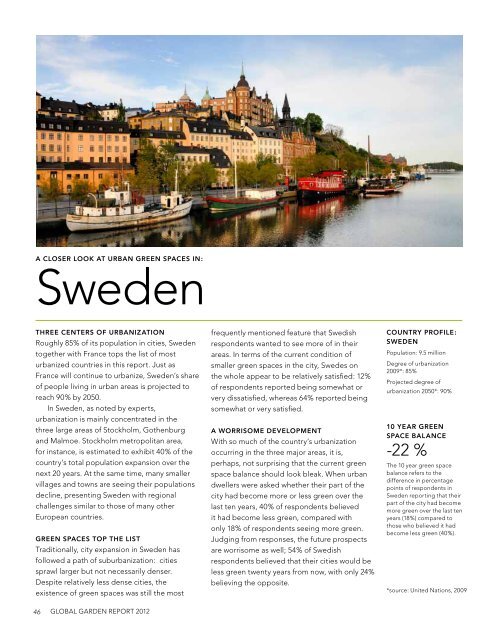GLOBAL GARDEN REPORT 2012 - Husqvarna Group
GLOBAL GARDEN REPORT 2012 - Husqvarna Group
GLOBAL GARDEN REPORT 2012 - Husqvarna Group
You also want an ePaper? Increase the reach of your titles
YUMPU automatically turns print PDFs into web optimized ePapers that Google loves.
A CLOSER LOOK AT URBAN GREEN SPACES IN:<br />
Sweden<br />
THREE CENTERS OF URBANIZATION<br />
Roughly 85% of its population in cities, Sweden<br />
together with France tops the list of most<br />
urbanized countries in this report. Just as<br />
France will continue to urbanize, Sweden’s share<br />
of people living in urban areas is projected to<br />
reach 90% by 2050.<br />
In Sweden, as noted by experts,<br />
urbanization is mainly concentrated in the<br />
three large areas of Stockholm, Gothenburg<br />
and Malmoe. Stockholm metropolitan area,<br />
for instance, is estimated to exhibit 40% of the<br />
country’s total population expansion over the<br />
next 20 years. At the same time, many smaller<br />
villages and towns are seeing their populations<br />
decline, presenting Sweden with regional<br />
challenges similar to those of many other<br />
European countries.<br />
GREEN SPACES TOP THE LIST<br />
Traditionally, city expansion in Sweden has<br />
followed a path of suburbanization: cities<br />
sprawl larger but not necessarily denser.<br />
Despite relatively less dense cities, the<br />
existence of green spaces was still the most<br />
46 <strong>GLOBAL</strong> <strong>GARDEN</strong> <strong>REPORT</strong> <strong>2012</strong><br />
frequently mentioned feature that Swedish<br />
respondents wanted to see more of in their<br />
areas. In terms of the current condition of<br />
smaller green spaces in the city, Swedes on<br />
the whole appear to be relatively satisfied: 12%<br />
of respondents reported being somewhat or<br />
very dissatisfied, whereas 64% reported being<br />
somewhat or very satisfied.<br />
A WORRISOME DEVELOPMENT<br />
With so much of the country’s urbanization<br />
occurring in the three major areas, it is,<br />
perhaps, not surprising that the current green<br />
space balance should look bleak. When urban<br />
dwellers were asked whether their part of the<br />
city had become more or less green over the<br />
last ten years, 40% of respondents believed<br />
it had become less green, compared with<br />
only 18% of respondents seeing more green.<br />
Judging from responses, the future prospects<br />
are worrisome as well; 54% of Swedish<br />
respondents believed that their cities would be<br />
less green twenty years from now, with only 24%<br />
believing the opposite.<br />
COUNTRY PROFILE:<br />
SWEDEN<br />
Population: 9.5 million<br />
Degree of urbanization<br />
2009*: 85%<br />
Projected degree of<br />
urbanization 2050*: 90%<br />
10 YEAR GREEN<br />
SPACE BALANCE<br />
-22 %<br />
The 10 year green space<br />
balance refers to the<br />
difference in percentage<br />
points of respondents in<br />
Sweden reporting that their<br />
part of the city had become<br />
more green over the last ten<br />
years (18%) compared to<br />
those who believed it had<br />
become less green (40%).<br />
*source: United Nations, 2009

















